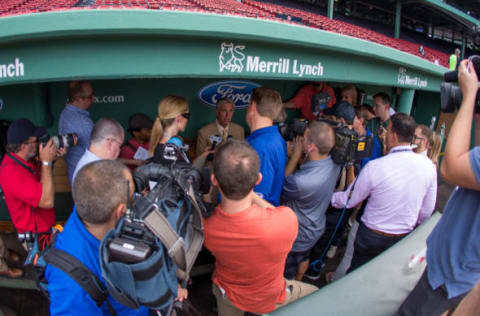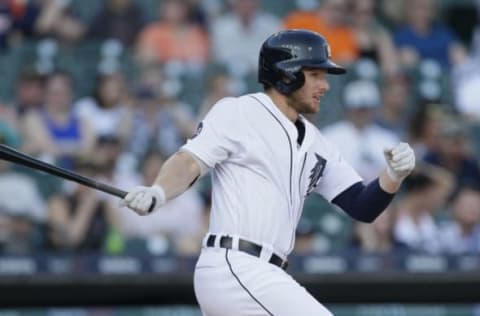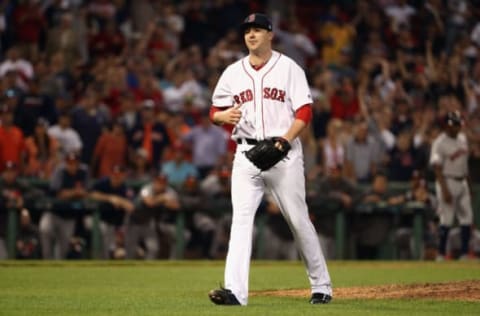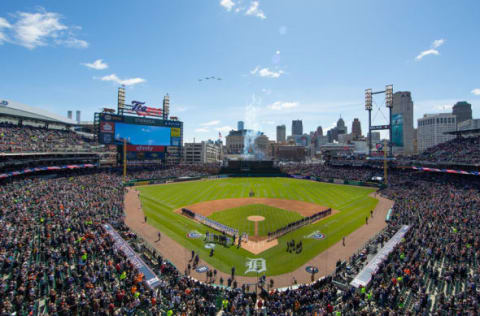Detroit Tigers should make this trade with the Boston Red Sox


Detroit Tigers executive vice president of baseball operations and general manager Al Avila could conceivably make some trades this offseason. One potential trade partner is Boston.
Detroit Tigers remember Dave Dombrowski’s time with the team well.
The franchise’s former general manager guided the team to a pair of World Series berths and five total playoff appearances in his time in the Motor City.
However, Dombrowski also gutted Detroit’s farm system of plenty of minor league talent along the way as the team chased a World Series title.
While that strategy worked for a while, it eventually failed the Tigers. The team has finished last in the division in two for the last three seasons and is destined for a full-scale rebuild.
Of course, Dombrowski is now the general manager in Boston. While in Beantown, he has flipped plenty of high-end prospects (see Yoan Moncada, Michael Kopech and Manuel Margot) for Major League upgrades.
The Red Sox’ current president of baseball operations has seemingly developed another strategy, and that’s amassing former Tigers players.
Of course, it isn’t unheard of to see general managers acquire players they’re familiar with.
However, in his time with Boston, Dombrowski has brought in the likes of David Price, Bryan Holaday, Brennan Boesch, Jhonny Peralta, Rajai Davis and Doug Fister.
Whether he acquires any more Tigers or ex-Tigers remains to be seen, but the Detroit Tigers and Boston Red Sox do match up as conceivable trade partners.
Here ‘s a hypothetical trade that would benefit both parties.

Detroit adds more position-player prospects close to the Majors
The trade:
Detroit Tigers acquire: reliever Carson Smith, first baseman Sam Travis and third baseman Michael Chavis.
Boston Red Sox acquire: relievers Shane Greene and Alex Wilson, utility player Andrew Romine and outfielder Alex Presley.
If the Tigers move Shane Greene this winter, the team should be able to get a premium return for him.
And this (gestures to hypothetical trade text) is a premium return.
Justin Wilson (along with Alex Avila) netted Detroit a pair of high-end prospects in Candelario and Isaac Paredes.
This trade is similar, only the Tigers should snag more in a deal for Greene.
According to Spotrac, Wilson will hit free agency after the 2018 campaign. In other words, the Tigers essentially traded one and a half seasons of Wilson to the Cubs.
If Greene is moved this offseason, Detroit would be dealing three seasons of the 28-year-old, who per Spotrac has three years of controllability left before becoming a free agent.
Just for comparison’s sake, here’s a look at Wilson’s stats before his trade to Chicago as well as Greene’s numbers once he himself took over as closer.
Justin Wilson’s stats from April 4 to July 29: 40.1 IP, 3.47 xFIP, .210 BABIP, 12.27 strikeouts per nine innings, 3.57 walks per nine innings, 83.9 LOB% and a 38.4 ground ball percentage.
Shane Greene’s stats from August 1 to September 30: 21.2 innings pitched, 3.68 xFIP, .302 BABIP, 9.55 strikeouts per nine innings, 3.74 walks per nine innings, 88.2 LOB% and a 46.4 ground ball percentage.
Obviously Greene had fewer opportunities with the Tigers struggling down the stretch.
However, he was similarly effective to Wilson, albeit with a tad more ground ball outs than strikeouts.
Not only does the right-hander have closing experience, but he can also pitch as a setup man or as a situational, multi-inning reliever.
This should boost his trade value considerably.
The Tigers’ closer would help fill a late-inning need for a Boston team that will see Addison Reed, Fernando Abad and Blaine Boyer hit the free agent market.
Meanwhile, Robbie Ross and Tyler Thornburg both missed significant time last season due to injury.
Ross appeared in just eight games, while Thornburg didn’t pitch at all.

Boston’s (hypothetical) haul
Meanwhile, the Red Sox would also pick up a pair of bench cogs in Romine and Presley and another relief arm in Wilson.
Romine already plays a similar role to Brock Holt, but Boston will see Eduardo Nunez become a free agent at the conclusion of the World Series.
Adding Romine ensures the team has a utility option in case Brock Holt is needed to play full time at a different position due to injury or ineffectiveness.
What’s more, with Davis and Chris Young also seeing their respective contracts expire this winter, Boston will have just one other outfielder besides starters Andrew Benintendi, Mookie Betts and Jackie Bradley Jr. on the 40-man roster in Tzu-Wei Lin.
After a resurgent 2017 at the plate (.354 on-base percentage, 106 wRC+ and a .334 wOBA) Presley would be a quality fourth outfielder with the Red Sox.
Alex Wilson
Alex Wilson isn’t exactly the late-inning arm that Justin Wilson or Greene is in terms of missing bats, but he’s been plenty effective since donning a Detroit uniform.
From the start of the 2015 season through the conclusion of the 2017 campaign, Wilson ranks 15th among relievers in innings pitched and has the 15th-lowest walk per nine innings rate and the 12th-lowest walk percentage.
He also owns a 3.75 xFIP and a 1.21 WHIP over that span.
While he may not post the flashy strikeout numbers as his fellow relievers, Wilson could be a quality sixth or seventh inning option for the Red Sox.
The needs are certainly there for Boston.
The need is also there for the Tigers, who would pick up some intriguing pieces in this hypothetical swap.

Detroit’s side of the (hypothetical) deal
In return, the Detroit Tigers would receive Greene’s potential replacement in Carson Smith.
Smith, who according to Spotrac is also controllable for the next three seasons, has served as a closer before.
The 28-year-old saved 13 games for the Seattle Mariners in 2015, while also finishing 24 games in the process that season.
He worked to a 2.31 ERA, a 2.12 FIP and 11.8 strikeouts per nine innings that season. The reliever also allowed just 22 walks in in 70 frames for the M’s.
Dombrowski nabbed Smith along with Roenis Elias from Seattle for Wade Miley and Jonathan Aro in a lopsided move that evoked the original Doug Fister trade.
However, Smith has been limited by injury since the move, pitching in just 11 games (9.1 innings) since the deal due to Tommy John surgery.
If he can find his form, Smith has a chance to be an impact reliever late in games.
Detroit would also snag two potential building blocks in Travis and Chavis.
Sam Travis
Travis is a right-handed hitting first baseman who has already broken into the big leagues. The 24-year-old garnered 83 plate appearances for the Sox in 2017.
While his numbers in an extremely small sample (.296 wOBA, 78 wRC+) won’t excite, there’s plenty of upside to be had.
MLB.com’s MLB Pipeline wrote the following about Travis:
“Travis is a polished right-handed hitter who lets his power come naturally rather than worrying about homers. He recognizes pitches, controls the strike zone and makes loud contact from gap to gap. He has the bat speed and strength to hit 20 or more homers per season if he were to adopt a more aggressive approach, which he may have to do to fit the first-base profile.”
While Boston will see Mitch Moreland reach free agency this winter, Travis may still be buried on the depth chart.
If the Red Sox sign a power bat like J.D. Martinez or Justin Upton this offseason, the club may rotate said player with Benitendi and Betts between the outfield and designated hitter.
This would move Hanley Ramirez back to first base.
In Detroit, Travis would be able to slot in right away as the team’s first baseman.
This would let Miguel Cabrera see the majority of his plate appearances at designated hitter, a move that would remove the risk of getting injured in the field from the equation for the future Hall of Famer.

Bright future
Adding a younger, Major-League ready player like Travis would also help to accelerate Detroit’s rebuild.
The sooner the franchise’s young players start making it to the Majors, the sooner they can develop. The sooner they can develop, the sooner the Detroit Tigers will contend again.
Speaking of young players near the Majors, there’s also Michael Chavis in this hypothetical trade.
Chavis recently wrapped up the 2017 campaign with Double-A Portland in Boston’s minor league system.
He hit .282 with a .347 on-base percentage, a .563 slugging percentage and a .910 OPS in 524 plate appearances.
Those 524 plate appearances also yielded 94 RBI, 89 RBI, 35 doubles, 31 home runs, two triples and two stolen bases.
A slugger in his own right, Baseball Prospectus wrote the following about the third baseman on August 24:
“Chavis’ game is built on his ability to drive the baseball, but everything else is a bit fringy. His swing is strong, powerful, compact and fast, but his bat-to-ball is inconsistent due to his aggressiveness and some approach issues. He has enough natural skill to hit for a workable average with power … His glove and footwork make me question whether third base is his long-term defensive home, but he has enough natural range to work in second or left field.”
Blocked by Rafael Devers at third base, Dustin Pedroia at second and Benintendi and Betts in the outfield corners, Chavis is an ideal trade chip for Boston.
Potential in Detroit
If the Tigers acquired Chavis, a move off third base would perfectly fine considering the franchise’s other options.
With Candelario entrenched at the moment at third, Detroit doesn’t need another third baseman.
What the team does need is a second baseman.
In the event that Ian Kinsler is traded, Dixon Machado is currently the only viable option to step in.
Long term however, the slick-fielding Machado seems more like Jose Iglesias’ heir apparent at shortstop.
As it stands, Dawel Lugo is Detroit’s only other candidate at second base long-term, so adding Chavis would certainly give the team another option.
At worst, if his offense plays in the Majors, the Tigers can shift Chavis elsewhere on the diamond.
Chavis would join the likes of Franklin Perez, Christin Stewart, Beau Burrows and Lugo in debuting in 2019 or 2020.
Next: This versatile, slugging FA is a fit for the Tigers.
Add in players like Travis and Smith, as well as some of the other top prospects in the system, and the Detroit Tigers will be in for an extremely bright future.